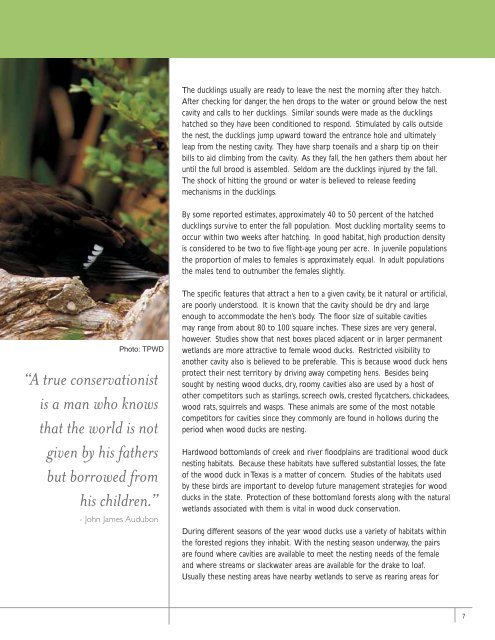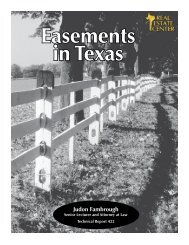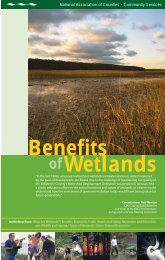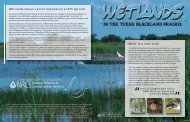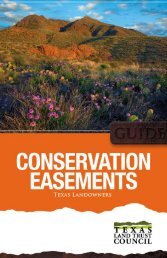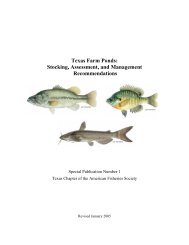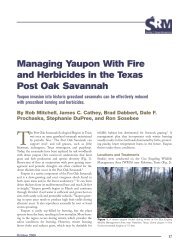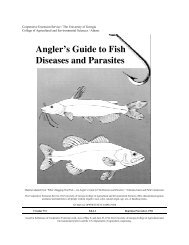Managing for Wood Ducks in East Texas - Trinity Waters
Managing for Wood Ducks in East Texas - Trinity Waters
Managing for Wood Ducks in East Texas - Trinity Waters
Create successful ePaper yourself
Turn your PDF publications into a flip-book with our unique Google optimized e-Paper software.
The duckl<strong>in</strong>gs usually are ready to leave the nest the morn<strong>in</strong>g after they hatch.<br />
After check<strong>in</strong>g <strong>for</strong> danger, the hen drops to the water or ground below the nest<br />
cavity and calls to her duckl<strong>in</strong>gs. Similar sounds were made as the duckl<strong>in</strong>gs<br />
hatched so they have been conditioned to respond. Stimulated by calls outside<br />
the nest, the duckl<strong>in</strong>gs jump upward toward the entrance hole and ultimately<br />
leap from the nest<strong>in</strong>g cavity. They have sharp toenails and a sharp tip on their<br />
bills to aid climb<strong>in</strong>g from the cavity. As they fall, the hen gathers them about her<br />
until the full brood is assembled. Seldom are the duckl<strong>in</strong>gs <strong>in</strong>jured by the fall.<br />
The shock of hitt<strong>in</strong>g the ground or water is believed to release feed<strong>in</strong>g<br />
mechanisms <strong>in</strong> the duckl<strong>in</strong>gs.<br />
By some reported estimates, approximately 40 to 50 percent of the hatched<br />
duckl<strong>in</strong>gs survive to enter the fall population. Most duckl<strong>in</strong>g mortality seems to<br />
occur with<strong>in</strong> two weeks after hatch<strong>in</strong>g. In good habitat, high production density<br />
is considered to be two to five flight-age young per acre. In juvenile populations<br />
the proportion of males to females is approximately equal. In adult populations<br />
the males tend to outnumber the females slightly.<br />
Photo: TPWD<br />
“A true conservationist<br />
is a man who knows<br />
that the world is not<br />
given by his fathers<br />
but borrowed from<br />
his children.”<br />
- John James Audubon<br />
The specific features that attract a hen to a given cavity, be it natural or artificial,<br />
are poorly understood. It is known that the cavity should be dry and large<br />
enough to accommodate the hen’s body. The floor size of suitable cavities<br />
may range from about 80 to 100 square <strong>in</strong>ches. These sizes are very general,<br />
however. Studies show that nest boxes placed adjacent or <strong>in</strong> larger permanent<br />
wetlands are more attractive to female wood ducks. Restricted visibility to<br />
another cavity also is believed to be preferable. This is because wood duck hens<br />
protect their nest territory by driv<strong>in</strong>g away compet<strong>in</strong>g hens. Besides be<strong>in</strong>g<br />
sought by nest<strong>in</strong>g wood ducks, dry, roomy cavities also are used by a host of<br />
other competitors such as starl<strong>in</strong>gs, screech owls, crested flycatchers, chickadees,<br />
wood rats, squirrels and wasps. These animals are some of the most notable<br />
competitors <strong>for</strong> cavities s<strong>in</strong>ce they commonly are found <strong>in</strong> hollows dur<strong>in</strong>g the<br />
period when wood ducks are nest<strong>in</strong>g.<br />
Hardwood bottomlands of creek and river floodpla<strong>in</strong>s are traditional wood duck<br />
nest<strong>in</strong>g habitats. Because these habitats have suffered substantial losses, the fate<br />
of the wood duck <strong>in</strong> <strong>Texas</strong> is a matter of concern. Studies of the habitats used<br />
by these birds are important to develop future management strategies <strong>for</strong> wood<br />
ducks <strong>in</strong> the state. Protection of these bottomland <strong>for</strong>ests along with the natural<br />
wetlands associated with them is vital <strong>in</strong> wood duck conservation.<br />
Dur<strong>in</strong>g different seasons of the year wood ducks use a variety of habitats with<strong>in</strong><br />
the <strong>for</strong>ested regions they <strong>in</strong>habit. With the nest<strong>in</strong>g season underway, the pairs<br />
are found where cavities are available to meet the nest<strong>in</strong>g needs of the female<br />
and where streams or slackwater areas are available <strong>for</strong> the drake to loaf.<br />
Usually these nest<strong>in</strong>g areas have nearby wetlands to serve as rear<strong>in</strong>g areas <strong>for</strong><br />
7


